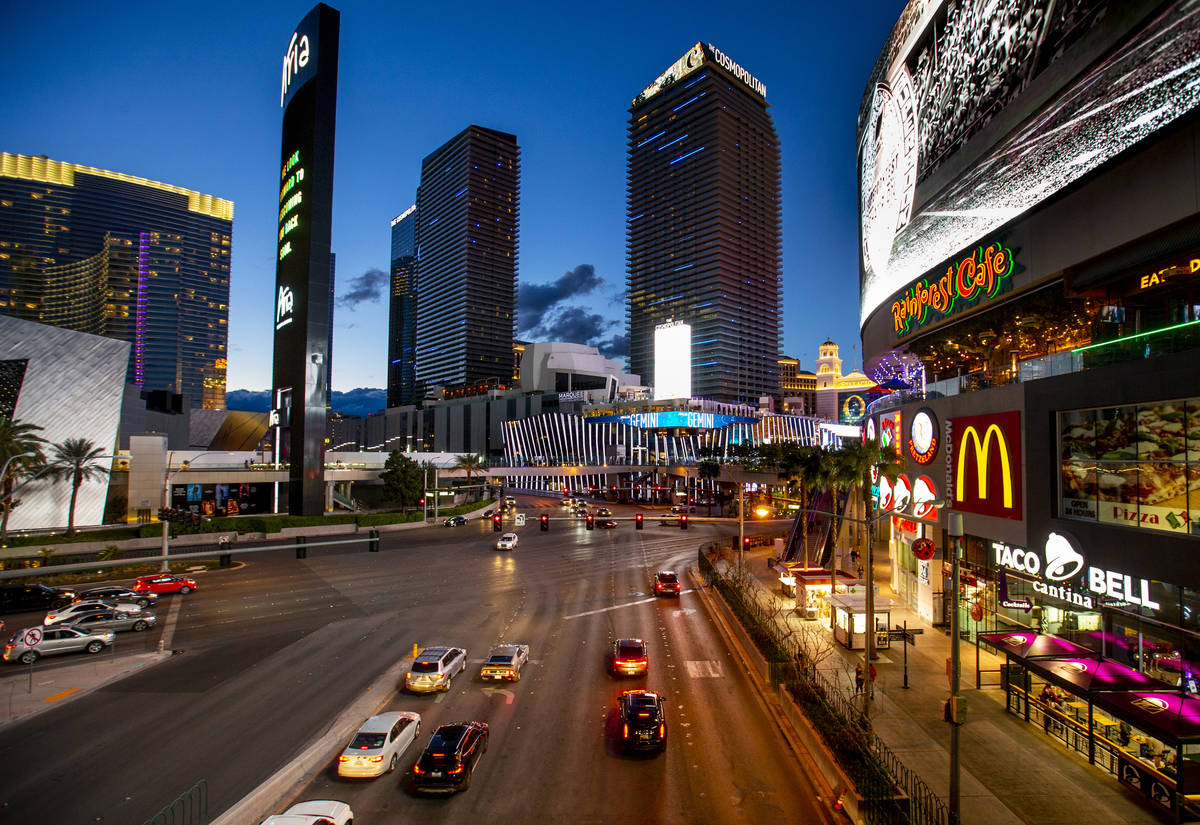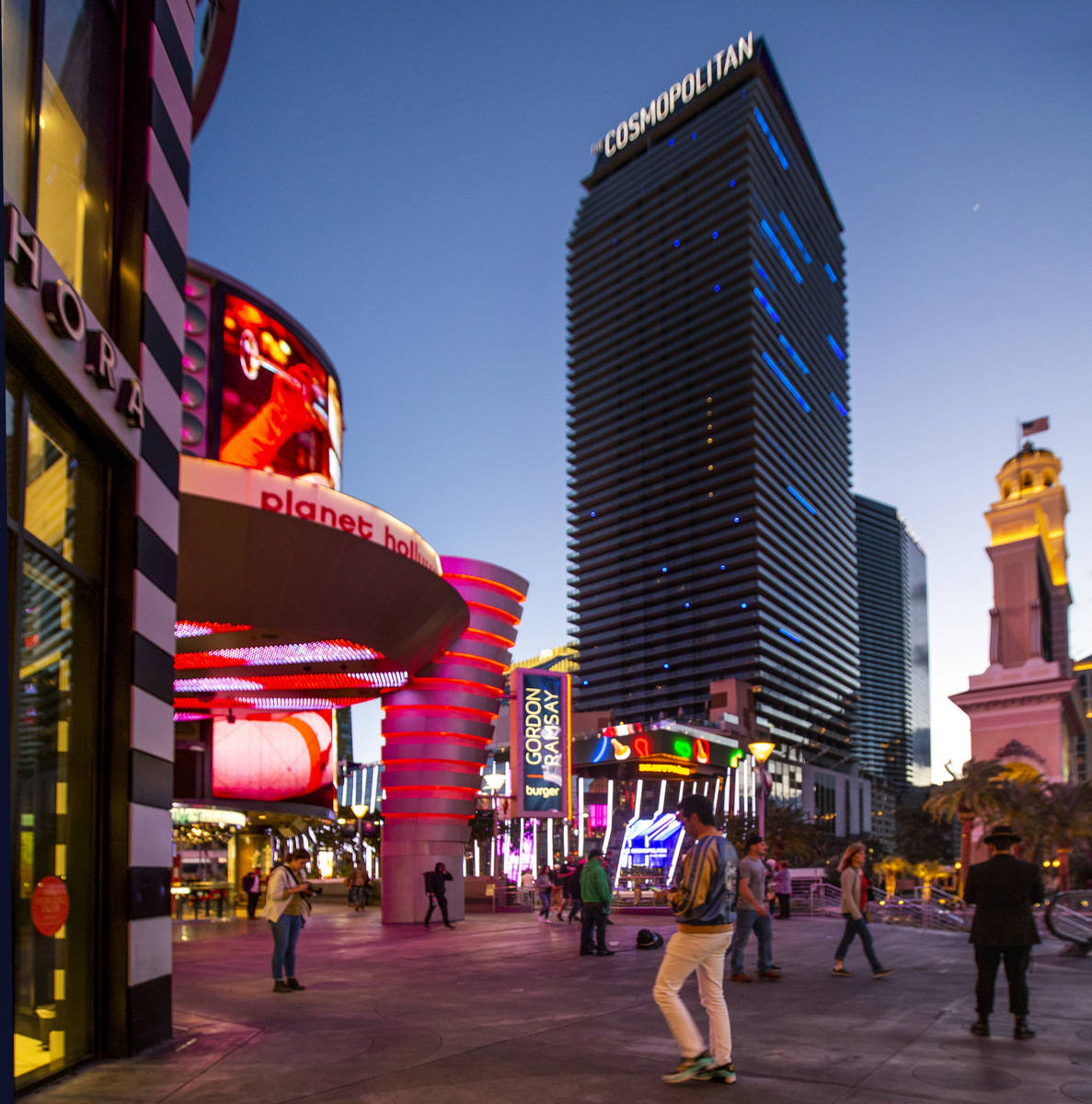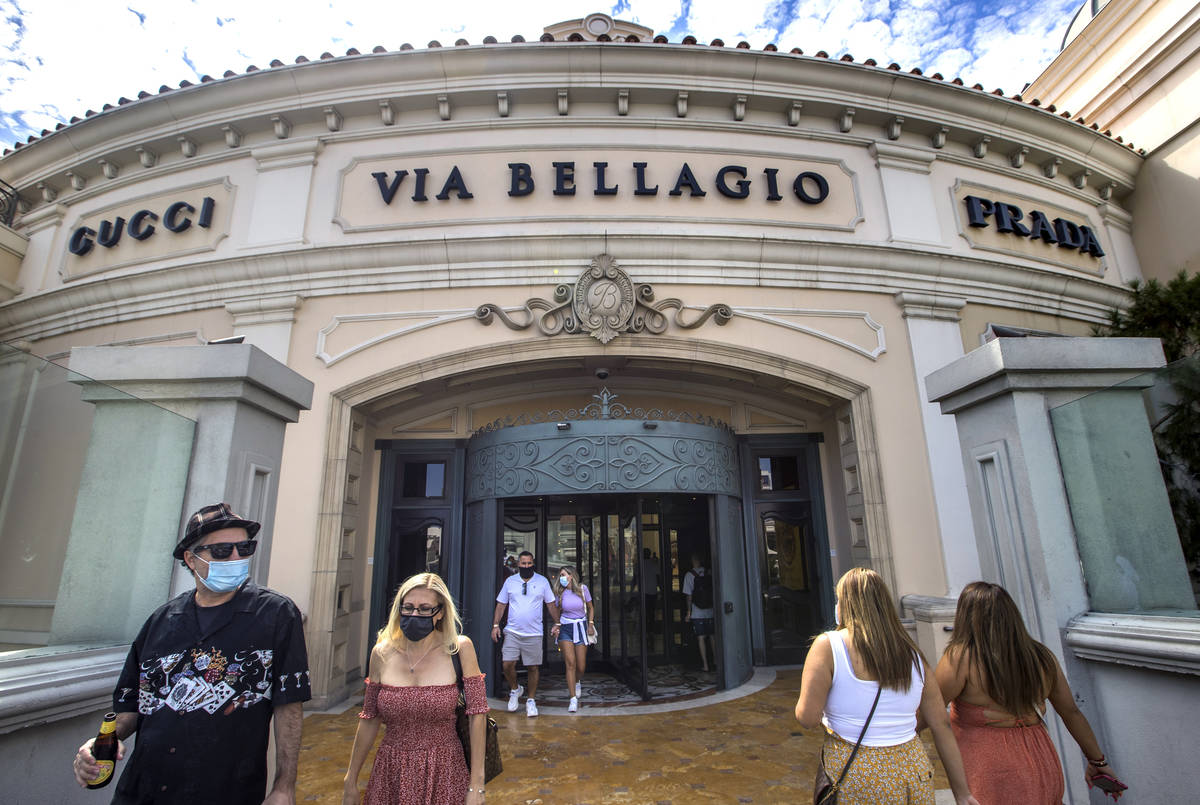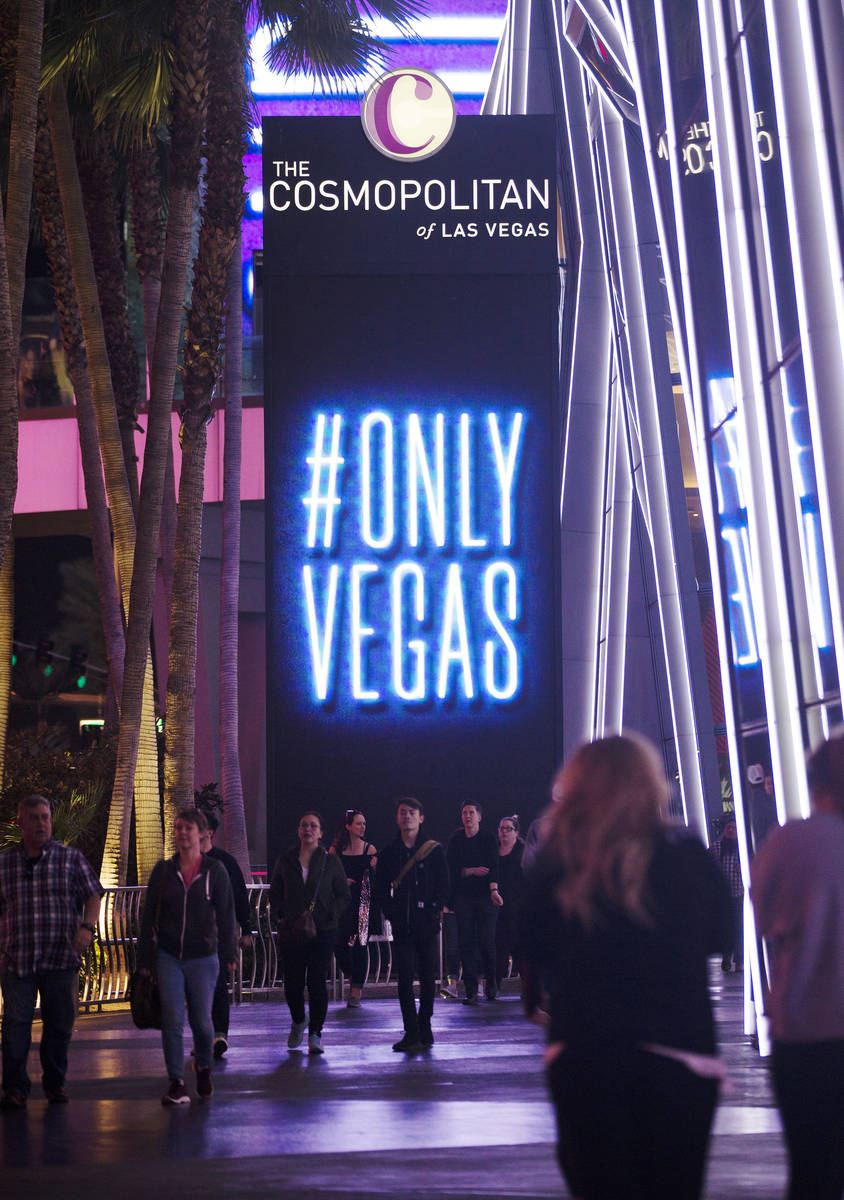Strip casinos dominate COVID tracing list; Cosmopolitan on top
The Cosmopolitan of Las Vegas topped reported locations of possible COVID-19 exposures in June, July and August in Southern Nevada, according to state disease investigation analyses obtained by the Review-Journal.
The resort ranked first in each of five analyses, with other Strip hotel-casinos also near the top. The analyses — one conducted in July and the remainder in August — show that since hotel-casinos reopened in early June, they have consistently ranked higher as “possible exposure sites” than any other types of businesses in Clark County.
“Clearly the data paint a picture of hotels and casinos being high risk for transmission,” said professor Samuel Scarpino, head of Northeastern University’s Emergent Epidemics Lab.
But state officials and casino representatives said the data does not provide clear evidence that hotel-casinos were the points of infection.
“This is more a reflection of general community spread than a specific issue with the employer or business, but it deserves investigation from the appropriate regulatory entities to confirm,” said Shannon Litz, a spokeswoman for the Nevada Department of Health and Human Services.
The analyses, released late Thursday after weeks of Review-Journal requests for the public records, follows the news organization’s report in June that Cosmopolitan employees said they felt unsafe because of increasing numbers of casino floor workers testing positive.
The Cosmopolitan said Friday in a statement that its top priority is keeping both its employees and guests healthy and safe.
“Since reopening in June, we have implemented and enforced an extensive set of health and safety policies and procedures, all of which meet or exceed the directives from local health and government authorities,” the statement read. “As we, along with our industry and country, further navigate through this unparalleled time, we continue to adapt our practices to ensure we are in alignment with the latest knowledge and guidance from medical and safety professionals.”
The government data newly obtained by the Review-Journal shows Strip casino-hotels have constituted the largest share of possible exposure locations in Nevada’s biggest metropolitan area. As of Friday, Clark County health officials reported more than 63,000 residents had contracted the virus and more than 1,300 of those had died.
The first analysis conducted in August, which focused on data collected since the start of Nevada’s COVID-19 outbreak in early March, showed that out of about 5,300 total respondents, almost 1,600 infected people reported being at a “hotel/motel.” Of those, about 1,300 had visited Strip hotel-casinos.
The five properties with the largest number of possible exposures, in order from greatest to least, were the Cosmopolitan (304), Bellagio (153), MGM Grand (133), The Venetian (89) and Caesars Palace (86). All were among the first Strip casino-hotels to reopen in June.
The only location other than casinos to crack the top of the list was the Clark County Detention Center, which tests all inmates. It ranked fourth overall with 93 cases.
The second-largest group of possible exposures, about 1,360, were in a nonspecific “other” category, which the state said represents businesses that do not align with other categories listed. When asked how many possible exposures were linked to protests, public demonstrations or political rallies, the state said only Southern Nevada Health District officials could answer the question.
“Food establishments,” a broad category including both restaurants and grocery stores, ranked third with about 700 cases.
Las Vegas possible COVID-19 exposure sites by Las Vegas Review-Journal on Scribd
The exposure location data released this week is based on voluntary self-reporting by people testing positive during the disease investigation or contact tracing process.
Health officials have emphasized the locations listed do not definitively represent where people caught the coronavirus. Instead, the lists represent locations most frequented by people during the time period when they probably became infected.
Yet the exposure-location data shed light on state officials’ announcement this week that approximately one in four infected people who spoke with Clark County disease investigators in the past month had visited a hotel, motel or resort. The announcement gave the first hard numbers, without specifics, related to the role Nevada’s tourism industry could be playing in the state’s outbreak.
Officials still have yet to identify any spreading events or case clusters beyond those at nursing homes and other state-licensed facilities. Instead, they have talked generally about “backyard barbecues” and “family gatherings” as primary causes of new infections.
The analyses should bring hotel-casinos back into the conversation, Scarpino said. Disease investigators should attempt to drill down on where inside the properties people report they may have contracted the disease.
“The only way in which we can have a more targeted intervention, that will keep large sectors of the economy open while bringing the case numbers under control, is to understand more specifically what the risk factors are within the hotels and casinos,” Scarpino said.
Cosmopolitan employees
The Review-Journal’s June story reported that Cosmopolitan employees were frustrated by the company’s response to COVID-19. One employee said Friday that visitors often act indifferently to the company’s health and safety rules.
“I don’t understand, but people don’t care. And we keep testing positive,” said the employee, who spoke to the Review-Journal on the condition of anonymity to protect the worker’s job.
Citing state officials, the Cosmopolitan wrote in its statement that the data “does not describe where or when someone contracted COVID-19, but merely what locations they visited during a certain period of time.”
But the assertion “doesn’t necessarily hold water,” said Oscar Alleyne, an epidemiologist and a senior adviser with the National Association of County and City Health Officials.
“The argument that they could have gotten this anywhere else, while that may be true, it is not reflected in the data,” he said.
Another expert said the data suggests there is “significant transmission of virus” to casino visitors, employees or both.
“This is suggestive at the very least there is something going on at the Cosmopolitan that needs to be fixed,” said North Carolina State University professor Julie Swann, who served as a science advisory for the H1N1 pandemic response to the Centers for Disease Control and Prevention.
The mid-sized 3,000-room Strip property, which opened in 2010, identifies as a luxury resort and tends to attract a younger, millennial crowd than some of its neighboring properties.
Epidemiologist Brian Labus, who serves on the governor’s medical advisory board for COVID-19, could draw few conclusions from the data, saying it is skewed by the casino sector’s robust employee testing programs.
Still, “I can’t imagine their (Cosmopolitan’s) testing program is way better than anybody else’s, but they do have a lot of positive (test results) in comparison to everybody else. If I was at the health district, that would definitely be something I’d want to look into a lot more,” said Labus, an assistant professor at UNLV.
The data obtained by the Review-Journal does not delineate hotel-casino employees from patrons.
However, Wynn Resorts on Thursday announced that nearly 550 of its workers had tested positive, and Las Vegas Sands Corp., which operates The Venetian and Palazzo, announced that more than 400 of its employees had tested positive.
Employee testing policies vary across casino companies. Some, like Wynn Resorts, regularly test a number of employees. Others, like MGM Resorts International, test all employees who are new or returning to work, but do not mandate tests for the majority of employees.
The Cosmopolitan’s safety protocols say any employees experiencing flu-like symptoms, or those who may have been potentially exposed to COVID-19, are immediately sent for testing and required to self-quarantine until they receive a negative diagnosis.
Members of the Nevada Resort Association have conducted more than 105,000 tests through company-driven employee testing programs since reopening, a spokeswoman for the lobbying agency said.
“Given the 1.5 million visitors in August and the nearly 100,000 employees working in the resort corridor combined with the robust internal employee testing and contact tracing programs resort companies have put in place, the expectation would be that large employers and the most popular locations with the largest volume of foot traffic would be among the locations mentioned during the contact tracing process,” said a statement from the association. It noted that the data does not mean the resorts were the points of infection.
MGM Resorts, which operates both Bellagio and MGM Grand, has encouraged, and often required, its employees to be tested, spokesman Brian Ahern wrote in a statement. The company was reporting cases involving an employee or guest to health officials.
“The positivity rate among our employees has almost consistently been below the positivity rate for the surrounding community since reopening,” Ahern wrote.
Sands has administered thousands of COVID-19 tests at its Las Vegas properties and provides monthly testing to its front-line employees, spokesman Keith Salwoski wrote in a statement.
“Las Vegas Sands has been focused on the health, safety and well-being of its Team Members from the very beginning of the pandemic,” Salwoski wrote.
In an email, Caesars Entertainment spokeswoman Kristin Soo Hoo deferred to the Nevada Resort Association’s statement, which the company helped craft.
Businesses on the list
The state data lists businesses from a number of economic sectors, including health care providers, a manufacturing plant and food establishments.
The Allegiant Stadium construction site ranked sixth-highest in the July analysis, which was based on disease investigation interviews conducted from June 1 to July 13.
In the August analyses, the Clark County Detention Center was listed in the top 10 each week. In various weeks, the top 10 also included McCarran International Airport and two skilled nursing facilities. Analyses were conducted once a week and looked at the past 30 days of data.
In the past month, key pandemic metrics showed improving numbers, but death numbers and hospitalizations rebounded in data released this week, a possible indicator of infection spread in Labor Day crowds. In July and August, the state saw a growing positivity rate and high numbers of deaths. This week, Sisolak announced bars and taverns can reopen statewide.
The newly released data raises questions about the state’s reopening strategy, Alleyne said.
Transmission of COVID-19 at Strip hotel-casinos could not only endanger local workers and patrons, but it also poses a “significant risk” to tourists who could contract the disease and bring it back to their communities, he said.
Complicating matters is that when tourists test positive in their home state after visiting Las Vegas, that information frequently does not make it back to Nevada.
Approximately 2.5 million visitors came to Las Vegas in June and July, according to official tourism data. As of Aug. 15, state health officials reported knowing of only 11 out-of-state visitors to Nevada who tested positive after they returned home.
Editor’s Note: A previous version of this story incorrectly described the timeframe for data contained in a state analysis of possible COVID-19 exposure locations. The state’s first analysis in August reflects data gathered since the state’s outbreak began in March.
The Review-Journal is owned by the family of Las Vegas Sands Corp. Chairman and CEO Sheldon Adelson. Las Vegas Sands operates The Venetian and Palazzo.
Contact Michael Scott Davidson at sdavidson@reviewjournal.com or 702-477-3861. Follow @davidsonlvrj on Twitter. Contact Mary Hynes at mhynes @reviewjournal.com or 702-383-0336. Follow @MaryHynes1 on Twitter. Review-Journal staff writer Bailey Schulz contributed to this report.






















